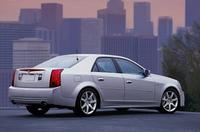New Car Review: 2004 Cadillac CTS-V
THE AUTO PAGE
By
JOHN HEILIG
SPECIFICATIONS
MODEL: Cadillac CTS-V
ENGINE: 5.7-liter V8
HORSEPOWER/TORQUE: 400 hp @ 6,000 rpm/395 lb-ft @ 4,800 rpm
TRANSMISSION: 6-speed manual
WHEELBASE: 113.4 in.
LENGTH x WIDTH x HEIGHT: 191.5 x 70.6 x 57.3 in.
STICKER
PRICE: $49,995
Cadillac's total redesign has spurred the renaissance of General Motors. Where the brand and the corporation had become stodgy in recent years, the new line of Cadillac models has proven to bring new blood into the market as well as bringing new design directions into GM. A lot of the credit for Cadillac's visual redesign belongs to former design VP Wayne Cherry and former Cadillac general manager John Smith, whose joint vision created excitement for the over-50 crowd.
The CTS was the first Cadillac to be redesigned. As the original Catera it is a mid-size car with dramatic lines.
Now Cadillac has reinvented the CTS, too. With a 5.7-liter V8 engine shoehorned under the hood, and a six-speed manual transmission to shift gears, the ultra-sharp CTS-V is a four-door Corvette. There are many people who would like to own a Corvette, but practical considerations preclude to ownership of a two-door coupe. The CTS-V solves that problem.
Also, Cadillac is using the CTS-V platform to build a race car that will compete in the 2004 SCCA Speed World Challenge series for production-based cars.
My CTS-V drive was centered around Los Angeles. My wife and I were in LA for the introduction of another car by another manufacturer and extended the "business" side of the trip for a short vacation. The car we were supposed to get as a loaner had been damaged and was replaced by the CTS-V.
In general appearance, the CTS-V isn't that different form the base CTS, which is powered by a 3.6-liter V6 engine. The slatted grille has been replaced by a mesh wire unit that gives the CTS-V a more purposeful look. But from the side, the two cars are almost identical.
Of course, under the hood there is a big difference. The V6 engine is rated at 255 horsepower, the V8 is rated at 400 horsepower. This is enough to propel the CTS-V from 0-60 mph in 4.6 seconds. We didn't do actual time checks, but merging onto the infamous California freeways and dealing with California drivers required all the power we could extract.
The six-speed manual gearbox was good, but we would have preferred an automatic/manual combination. The gearbox has Corvette's annoying first-to-fourth economy shift pattern that really detracts from the car if you're interested in less-than-high-performance driving. Also, if you have anything in the cupholders, shifting can only be accomplished by using fingertips and you end up with a sore wrist after a couple of hundred miles.
The sound from the engine is something you don't expect from a Cadillac. There's a throaty roar that is thrilling to generate.
A car that goes quickly must sop quickly, and the CTS-V stops in less space than any car I've driven. We made a couple of panic stops at reasonably low speeds and the car simply STOPS. Cadillac has equipped the CTS-V with four-piston Brembo brakes that are excellent.
The suspension system on the CTS-V is also beefed up. We took the car up into some of the canyons north of Malibu (we took a detour on Mulholland Drive, too, but that's not part of the test). These roads offer steep hills, tight turns in both directions, and little or no traffic on normal days. We've driven these roads in an assortment of high-performance cars and the CTS-V fits as well into that category as any other.
Instrumentation consists of a 180 mph speedometer, tachometer, fuel and water gauges. While the navigation system took some learning, we eventually were able to find our way around the city with no problems. We also used OnStar once or twice to find out-of-the-way stores and restaurants.
Seats are very comfortable in the CTS-V. Front seats offer excellent side support, which is necessary in a car that can produce high side g-forces.
Interior styling is highlighted. Among the styling touches we admired were the interior door handles.
The fat steering wheel had cruise control switches and the information system menu switches attached.
We averaged 14.2 mpg in the CTS-V. While this isn't great, it's decent for a V8 engine, especially one that we used to its maximum potential a couple of times. The biggest problem was filling the tank with $2.65 a gallon gasoline, when we can get the same stuff back East for 90 cents a gallon cheaper.
Cadillac may not get a lot of buyers for the CTS-V. Its appeal is somewhat limited. But if you're dreaming about a Corvette, yet need the extra doors and seats, then this is the car for you. At a bottom line sticker price of just under $50,000, it's definitely worth it.
© 2004 The Auto Page Syndicate



